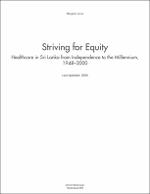Striving for Equity
Healthcare in Sri Lanka from Independence to the Millennium, 1948–2000
| dc.contributor.author | Jones, Margaret | |
| dc.date.accessioned | 2021-03-18T14:02:35Z | |
| dc.date.available | 2021-03-18T14:02:35Z | |
| dc.date.issued | 2020 | |
| dc.identifier | OCN: 1258395274 | |
| dc.identifier.uri | https://library.oapen.org/handle/20.500.12657/47401 | |
| dc.description.abstract | Focusing on the period from independence in 1948 to the millennium this book is an historical analysis of the process by which Sri Lanka became a model of how a nation with limited resources could nevertheless achieve health indicators on a par with the developed world through the development of a primary healthcare system. In so doing it had to interact and negotiate with global health actors such as the World Health Organization while maintaining its own agency. Based on a close reading of original archival sources it is an in-depth exploration of these questions viewed through a series of case studies which highlight both the successes which contributed to this outcome and the inadequacies of those efforts when seen at the micro level. A primary health care infrastructure is an essential prerequisite for the delivery of preventive health care; how this was developed and delivered to the entire population forms the first substantive chapter. Since the incidence of tuberculosis in a community serves as a marker of a country’s achievement in meeting basic needs and establishing social justice there follows an examination of policies to control TB. The most vulnerable group in a nation are its children and they are also the source of a nation’s future human capital. Two chapters discuss children’s health; firstly the problem of childhood malnutrition and secondly the implementation of the successful immunization programme. Demographic change means a double disease burden of non-communicable diseases alongside communicable diseases and how this considerable challenge is met is the subject of the last chapter. Furthermore these topics enable a discussion of the significance and problems of an international policy transfer to less well-resourced environments. | en_US |
| dc.language | English | en_US |
| dc.relation.ispartofseries | New Perspectives in South Asian History | en_US |
| dc.subject.classification | thema EDItEUR::N History and Archaeology::NH History | en_US |
| dc.subject.classification | thema EDItEUR::M Medicine and Nursing::MB Medicine: general issues::MBN Public health and preventive medicine | en_US |
| dc.subject.other | healthcare | en_US |
| dc.subject.other | history | en_US |
| dc.subject.other | tuberculosis | en_US |
| dc.subject.other | Sri Lanka | en_US |
| dc.title | Striving for Equity | en_US |
| dc.title.alternative | Healthcare in Sri Lanka from Independence to the Millennium, 1948–2000 | en_US |
| dc.type | book | |
| oapen.relation.isPublishedBy | 06afbe9e-f316-4cad-9514-a9bdd5f4032f | en_US |
| oapen.relation.isFundedBy | d859fbd3-d884-4090-a0ec-baf821c9abfd | en_US |
| oapen.collection | Wellcome | en_US |
| oapen.pages | 156 | en_US |

